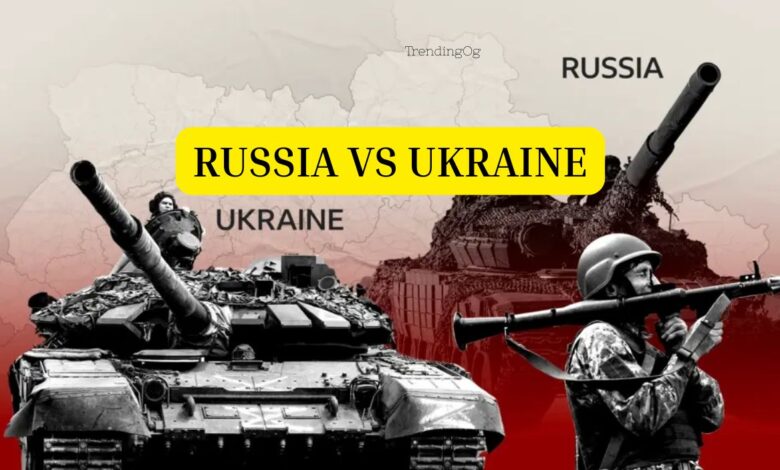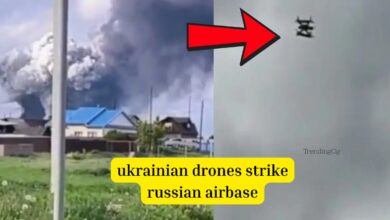Russia-Ukraine War: Ukrainian Drones Strike Russian Airbase, Escalating Tensions

The Russia-Ukraine war continues to escalate as Ukrainian drones strike a Russian airbase, marking another bold move in Kyiv’s strategy to weaken Moscow’s military capabilities. The latest attack targeted the Engels airbase, a key facility housing Russia’s long-range Tu-95 bombers, which have been used to launch devastating missile strikes on Ukrainian cities. This strike underscores Ukraine’s growing ability to hit strategic Russian assets, despite Moscow’s dominance in firepower.
As the conflict drags on, both nations are locked in a deadly struggle, with no clear end in sight. The war has reshaped global geopolitics, triggered severe economic repercussions, and left millions displaced. Here’s the latest on the Russia-Ukraine war, including recent attacks, military strategies, and the broader implications of this prolonged conflict.
Ukrainian Drones Hit Russian Airbase: A Strategic Blow
In a daring operation, Ukrainian drones struck the Engels airbase deep inside Russian territory, approximately 500 kilometers from the Ukraine border. This airbase is crucial for Russia’s strategic bombing campaigns, as it houses the Tu-95 “Bear” bombers—the same aircraft used to launch cruise missiles at Ukrainian infrastructure.
Key Details of the Attack:
-
Target: Engels-2 airbase in Russia’s Saratov region.
-
Aircraft Affected: At least two Tu-95 bombers reportedly damaged.
-
Method: Long-range drones, possibly modified for extended range.
-
Significance: Demonstrates Ukraine’s ability to strike high-value Russian military assets far from the frontlines.
This is not the first time Ukraine has targeted the Engels base. Similar strikes in late 2022 caused significant damage, temporarily disrupting Russia’s long-range bombing operations. The repeated attacks suggest that Ukraine is systematically degrading Russia’s ability to launch missile strikes from deep within its territory.
Russia’s Response: Escalation and Denial
The Kremlin has downplayed the impact of the drone strikes, claiming that Russian air defenses intercepted most of the drones with minimal damage. However, independent analysts and satellite imagery suggest otherwise, indicating that the attacks have disrupted operations at the base.
In retaliation, Russia has intensified missile and drone attacks on Ukrainian cities, targeting energy infrastructure and civilian areas. The recent wave of Russian airstrikes has left millions without power in freezing winter conditions, further straining Ukraine’s already battered energy grid.
Russia’s Military Adjustments:
-
Relocating Strategic Bombers: Reports suggest Russia may be moving its Tu-95 bombers farther east to prevent further Ukrainian strikes.
-
Increased Electronic Warfare: Russia is deploying more jamming systems to counter Ukrainian drones.
-
Expanded Drone Production: Moscow is ramping up its own drone manufacturing to match Ukraine’s growing capabilities.
The Broader War: Stalemate or Shifting Momentum?
The Russia-Ukraine war has entered a phase of attrition, with both sides struggling to achieve a decisive breakthrough. While Russia holds an advantage in artillery and manpower, Ukraine has leveraged Western-supplied weapons, guerrilla tactics, and drone warfare to level the playing field.
Current Frontline Situation:
-
Eastern Ukraine (Donbas): Heavy fighting continues around Bakhmut and Avdiivka, with Russia making incremental gains at a high cost.
-
Southern Ukraine (Kherson & Zaporizhzhia): Ukraine maintains pressure on Russian forces, but a major counteroffensive has yet to materialize.
-
Black Sea: Ukraine’s successful naval drone attacks have forced Russia to withdraw parts of its fleet from Crimea.
Western Military Aid: A Game-Changer?
Ukraine’s ability to strike deep into Russia relies partly on Western intelligence and technology. The U.S. and EU have supplied long-range missiles, advanced drones, and satellite data, enabling precision strikes like the one on the Engels airbase. However, delays in further aid—particularly from the U.S. Congress—could hinder Ukraine’s momentum in 2024.
Humanitarian and Global Impact
The war has exacted a horrific toll on civilians, with thousands killed and millions displaced. Cities like Mariupol, Kharkiv, and Kherson have been reduced to ruins, while Russian attacks on power plants have left Ukrainians struggling with blackouts.
Economic Consequences:
-
Russia: Despite Western sanctions, Moscow has sustained its war economy through oil sales to China and India.
-
Ukraine: Heavily reliant on foreign aid, with reconstruction costs estimated at over $400 billion.
-
Global Effects: Rising food and energy prices, particularly in developing nations dependent on Ukrainian grain.
What’s Next in the Russia-Ukraine War?
As both nations brace for another grueling year of conflict, several key developments could shape the war’s trajectory:
-
Ukraine’s Potential Spring Offensive: Will Kyiv launch another major push to reclaim territory?
-
Russia’s Winter Bombing Campaign: Will Moscow escalate attacks on Ukraine’s infrastructure?
-
Western Aid Uncertainty: Will U.S. and EU support remain steady, or will political shifts alter military assistance?
For now, the Russia-Ukraine war remains a brutal war of endurance, with neither side willing to back down. The latest Ukrainian drone strike on the Russian airbase proves that Kyiv is willing to take the fight deep into enemy territory—a sign that this conflict is far from over.



